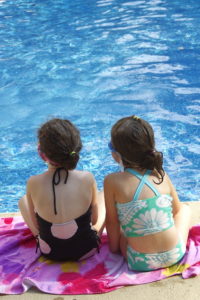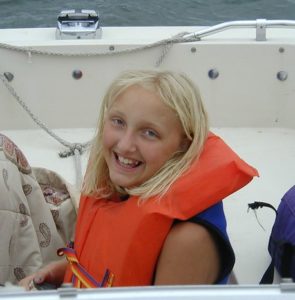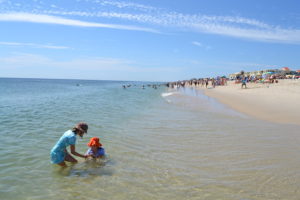Swimming is a fantastic form of exercise and a major component of many spring break trips and summer break fun. But parents should remember that swimming also comes with risk. Follow these tips from the American Academy of Pediatrics to protecting children from drowning.
POOL SAFETY
- Never leave children alone in or near the pool or spa, even for a moment; close supervision
 by a responsible adult is the best way to prevent drowning in children. Designate a “water watcher” who is not distracted or under the influence of drugs or alcohol to watch children in and near the water.
by a responsible adult is the best way to prevent drowning in children. Designate a “water watcher” who is not distracted or under the influence of drugs or alcohol to watch children in and near the water. - Whenever inexperienced swimmers are in or around water, an adult – preferably one who knows how to swim and perform CPR – should be within arm’s length, providing “touch supervision.”
- Install a fence at least 4 feet high around all four sides of the pool. The fence should not have openings or protrusions that a young child could use to get over, under, or through.
- The safest fence is one that surrounds all 4 sides of the pool and completely separates the pool from the house and yard. If the house serves as the fourth side of the fence, install an alarm on the exit door to the yard and the pool. For additional protection, install window guards on windows facing the pool. Drowning victims have also used pet doors to gain access to pools. Keep all of your barriers and alarms in good repair with fresh batteries.
- Make sure pool gates open out from the pool, and self-close and self-latch at a height children can’t reach. Consider alarms on the gate to alert you when someone opens the gate. Consider surface wave or underwater alarms as an added layer of protection.
- Keep rescue equipment (a shepherd’s hook – a long pole with a hook on the end — and life preserver) and a portable telephone near the pool. Choose a shepherd’s hook and other rescue equipment made of fiberglass or other materials that do not conduct electricity.

- Avoid inflatable swimming aids such as “floaties.” They are not a substitute for approved life jackets and can give children and parents a false sense of security.
- Children over age 1 may be at a lower risk of drowning if they have had some formal swimming instruction. However, there is no evidence that swimming lessons or water survival skills courses can prevent drowning in babies younger than 1 year of age.
- Everyone should learn to swim – Participation in formal swim lessons can reduce the likelihood of childhood drowning death by 88%
- The decision to enroll a child over age one in swimming lessons should be made by the parent based on the child’s developmental readiness and exposure to water, but swim programs should never be seen as “drown proofing” a child of any age.
- Avoid entrapment: Suction from pool and spa drains can trap a swimmer underwater. Do not use a pool or spa if there are broken or missing drain covers. Ask your pool operator if your pool or spa’s drains are compliant with the Pool and Spa Safety Act. If you have a swimming pool or spa, ask your pool service representative to update your drains and other suction fittings with anti-entrapment drain covers and other devices or systems. See PoolSafely.gov for more information on the Virginia Graeme Baker Pool and Spa Safety Act.
- Large, inflatable, above-ground pools have become increasingly popular for backyard use. Children may fall in if they lean against the soft side of an inflatable pool. Although such pools are often exempt from local pool fencing requirements, it is essential that they be surrounded by an appropriate fence just as a permanent pool would be so that children cannot gain unsupervised access.
- If a child is missing, look for him or her in the pool or spa first.
- Share safety instructions with family, friends and neighbors.
BOATING SAFETY
- Children should wear Coast Guard approved life jackets at all times when on boats, docks or near bodies of water.
- Make sure the life jacket is the right size for your child. The jacket should not be loose and should always be worn as instructed with all straps belted.

- Blow-up water wings, toys, rafts and air mattresses should not be used as life jackets or personal flotation devices. Adults should wear life jackets for their own protection, and to set a good example.
- Adolescents and adults should be warned of the dangers of boating even as a passenger when under the influence of alcohol, drugs, and even some prescription medications.
- Children follow your example, whenever you are on a boat – everyone, kids and adults should wear a life jacket.
OPEN WATER SWIMMING
- Never swim alone. Even good swimmers need buddies!
- A lifeguard (or another adult who knows about water rescue) needs to be watching children whenever they are in or near the water. Younger children should be closely supervised while in or near the water – use “touch supervision,” keeping no more than an arm’s length away.
- Designate a “water watcher” who is not distracted or under the influence of drugs or alcohol to watch children in and near the water.
- Make sure your child knows never to dive into water except when permitted by an adult who knows the depth of the water and who has checked for underwater objects.
- Never let your child swim in canals or any fast-moving water.
- Ocean swimming should only be allowed when a lifeguard is on duty.
- Teach children about rip currents. If you are caught in a rip current, swim parallel to shore until you escape the current, and then swim back to shore.

- Be aware that pools and beaches in other countries may not have lifeguards, and pools may have unsafe drain systems. Supervise children closely.
- At the beach, stay within the designated swimming area and ideally within the visibility of a lifeguard.
- Be aware of rip currents. If you should get caught in one, don’t try to swim against it. Swim parallel to shore until clear of the current.
- Seek shelter in case of storms. Get out of the water. Get off the beach in case of lightning.
Copyright © 2018 American Academy of Pediatrics.
Photo: Gordon {flickr}, eLLen {flickr}, Bradley West {flickr}, R Muller {flickr}

